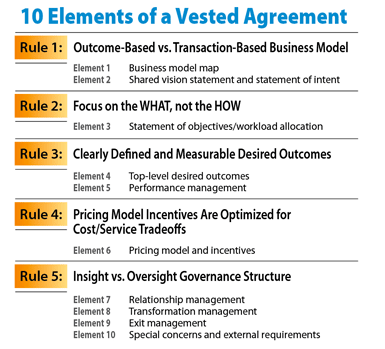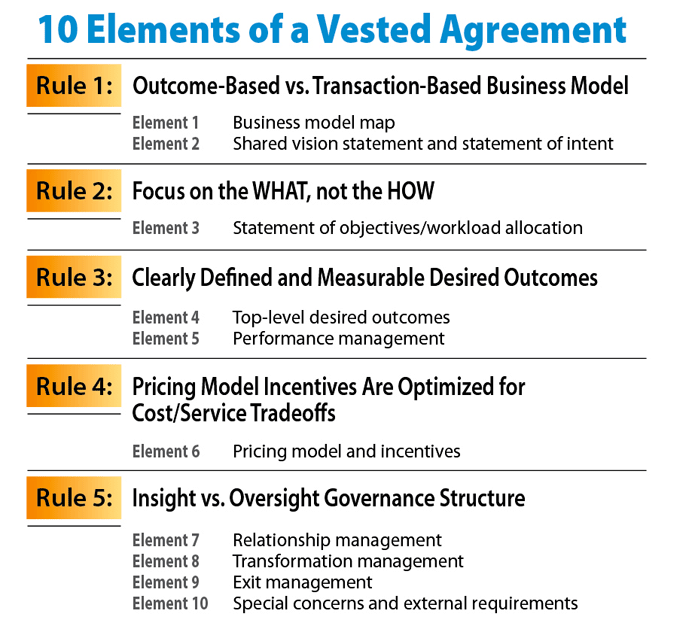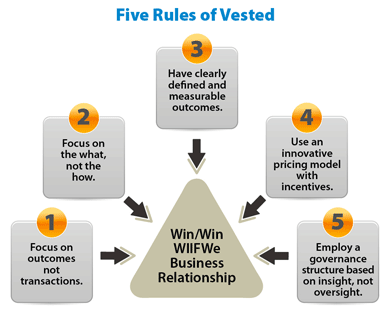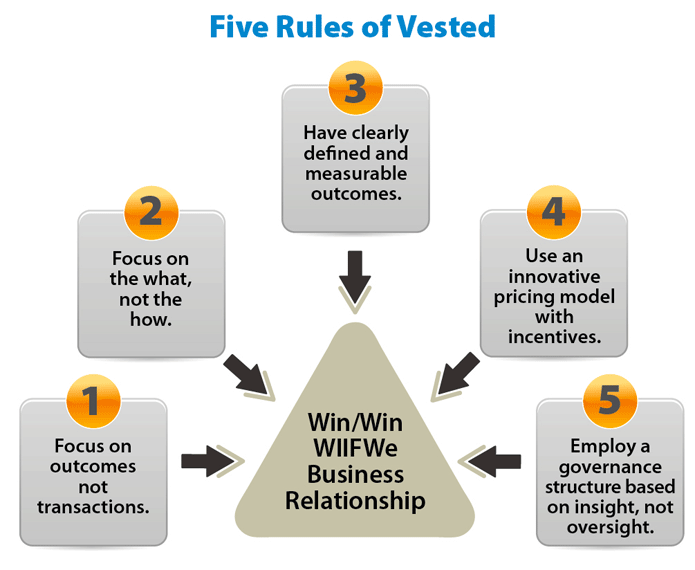The news headlines tell only a small part of the story; there’s much more to outsourcing than layoffs and foreign relocation, but it’s also true that outsourcing is facing complex and difficult challenges in the face of a sour global economy and the multiplicity of internal and external events that can — and do — disrupt the most carefully planned supply chains. Business happens, and if an outsourcing strategy is not flexible and nuanced enough to deal with that fact, then it’s time to change the way outsource contracts are negotiated and managed.
Contracts Steeped in Mutual Advantage
In 1968 legal scholar Ian R. Macneil observed that most contracts are ill-equipped to address the reality of business needs. In Contracts: Instruments for Social Cooperation1, Macneil wrote, “Somewhere along the line of increasing duration and complexity [the contract] escapes the traditional legal model.” He argued that contracts are rooted in the classical approach to contract law, and thus crafted to address transactions and legal protections such as pricing and price changes, service levels, limitation of liability, indemnification, and liquidated damages.
Those classical approaches to contract law are still around. An April 2010 study by the International Association of Contracting and Commercial Management (IACCM) concluded that contract terms remain mired in the classical legal approach of contract law, which focuses almost exclusively and hierarchically on pricing, limiting liability, indemnification, service and transaction levels, risk mitigation, and liquidated damages.
An example: a common mistake companies make in outsourcing today is that they create detailed statements of work (SOWs) and then strictly define the work to be done. This handcuffs their suppliers’ or service providers’ innovation and flexibility. A flexible approach and agreement framework is needed, one that the Nobel laureate Oliver Williamson suggests is highly adjustable or adaptable, rather than one that prescriptively outlines detailed transactions, rigid terms and conditions, SOWs, and working relations.3


The Vested approach requires the parties to jointly build a solid, cooperative foundation for sharing value. Progressive and highly integrated outcome-based business models use value incentives to maintain mutual advantage.
10 Elements of a Vested Outsourcing Agreement
So what are the 10 steps, or elements, that go into crafting a Vested business agreement? University of Tennessee’s Center for Executive Education teamed with the International Association of Contract and Commercial Management on The Vested Outsourcing Manual — a step-by-step guide for developing collaborative business-to-business agreements and working rules that will facilitate successful and long-lasting business relationships based on mutually desired outcomes.
The manual details 10 elements to include when developing an outsource contract. Think of the elements as signposts directing the parties along the right road to the desired destination: a successful, long-term business relationship. These 10 elements are keyed to implementing Vested’s “Five Rules” as shown in the accompanying chart.
Vested’s Five Rules


Element 1: Business model map — This first step is to understand and document an outsourcing business model. It is vital to map potential outcomes. The map will reveal how well the parties are aligned to each other’s goals, and will pinpoint the transactions of value between the parties, leading logically to collaboration, loyalty and mutual satisfaction, market share, and sustainable profit. Element 1 also fashions a culture in which the company and the service provider maximize profits by working together more efficiently, no matter who is doing the activity.
Element 2: Shared vision and statement of intent — With the business model understood and mapped, the parties then work together on a joint vision that will guide them for the duration of their relationship. A cooperative and collaborative mindset opens a conversation: The companies share what is needed, admit to gaps in capability, and each aims to focus on the benefits that the other party can bring to enhance any gaps in capability. That vision and alignment forms the basis of a “Statement of Intent” drafted by the outsourcing teams.
Rule #2: Focus on the What, Not the How
Element 3: Statement of objectives/workload allocation — This element lays the foundation for the businesses to do what they do best. Depending on the scope of the partnership, the company transfers some or all of the activities needed to accomplish agreement goals to the supplier/service provider. Together they develop a statement of objectives (SOO), which is very different from a standard SOW. This is a vital distinction: A SOO describes intended results, not tasks. Based on the SOO, a service provider will draft a performance work statement that defines in more detail the work to be performed and the results expected from that work.
Rule #3: Clearly Defined and Measurable Outcomes
Element 4: Top-level desired outcomes — To have an effective, successful Vested relationship, the parties must work together to define and quantify desired outcomes. This element is the centerpiece of the whole enterprise because without mutually defined desired outcomes in place, the Vested approach cannot move forward. Outcomes are expressed in terms of a limited set of high-level metrics. It is imperative that the parties spend time — jointly and collaboratively — during the outsourcing transition, and particularly during agreement negotiations, to define exactly how relationship success is measured. Once the desired outcomes are stipulated, the supplier proposes a solution that will deliver the required level of performance at a predetermined price.
Element 5: Performance management — Once desired outcomes, statements of intent and SOOs are in place and the agreement is implemented, the parties then measure performance to determine if the goals are achieved. These include high-level performance management measures that are easily understood by business stakeholders and all parties involved in the process. The metrics will help align performance to strategy.
Rule #4: Optimize Pricing Model Incentives
Element 6: Pricing model and incentives — The parties must have a properly structured pricing model that incorporates incentives for the best cost and service trade-off. The approach of many procurement professionals to outsourcing is perennially stuck on one thing: getting the lowest possible service and labor pricing. The strategic bet — and paradigm shift — of Vested is that the supplier or service provider’s profitability is directly tied to meeting the mutually agreed upon desired outcomes. Inherent in this model is a reward for service providers to invest in process, service, or associated product that will generate returns in excess of agreement requirements. Obviously higher profits are not guaranteed, but this element provides service providers with the authority and autonomy to make strategic investments in processes and product reliability that can generate more value and a greater return on investment than a conventional cost-plus or fixed-price-per-transaction agreement might yield.
Incentives are a key component of this mix because service providers are taking on risk to generate larger returns on investment. An incentives package delivers the most commercially efficient method of maintaining equitable margins for all parties for the duration of the relationship. Pricing models that use margin matching are recommended for use in this type of relationship. The margin matching method is used to adjust pricing points by establishing trigger points that reset prices when that point is met. For example, the inflation rate might be a trigger point for resetting inventory carrying cost charges.
Rule #5: Insight Vs. Oversight Governance Structure
Element 7: Relationship management — A relationship management structure creates joint policies that emphasize the importance of building collaborative working relationships, attitudes, and behaviors. The four elements associated with Rule 5 provide the tools for parties to manage and operate their agreement. The parties monitor the agreement within the framework of a flexible governance structure that provides top-to-bottom insights into what is happening. Vested is not based on transaction counting!
Element 8: Transformation management — This is a new relationship model — people and company ecosystems are changing; the parties are doing things differently and probably not operating in familiar comfort zones. Managing this transformation, including transitioning from old to new — along with change management once the new agreement is up and running — is often difficult and complex to implement. It is imperative to preserve as much continuity as possible among personnel and teams as the transition progresses into day-to-day implementation and operation. The focus here is on end-to-end business metrics, mutual accountability for the desired outcomes, and the creation of a culture that rewards innovation, agility, and continuous improvement.
Element 9: Exit management — Sometimes the best plan simply does not work out or is trumped by unexpected events. Business happens, and companies should have a plan when assumptions change. An exit management strategy can provide a template to handle future unknowns. The goal is to establish a fair plan and to keep the parties whole in the event of a separation when the separation is not a result of poor performance.
Element 10: Special concerns and external requirements — Governance frameworks are not one-size-fits-all, especially in more technical or complex relationships. The final element recognizes that agreements are different and that many companies and service providers must understand and adhere to special requirements and regulatory protocols. Thus, a governance framework may need to include additional provisions that address specific market, local, regional, and national requirements. For instance, in supplier and supply chain relationships involving information technology and intellectual property, security concerns may necessitate special governance provisions outside the normal manufacturer-supplier relationship. Supply chain finance and transportation management are other areas that often require special handling under the parties’ specific governance framework.
In Sum
Developing a business or outsourcing agreement using Vested’s Five Rules and the 10 Elements is much more than delivering a higher level of service on a given activity, a blur of metrics, or simply counting transactions or filling seats more cheaply. The 10 elements enable progressive companies to change their mindset and challenge old-school approaches by establishing a dynamic, modern business-to-business agreement. By developing outsource agreements that include the 10 elements, firms learn by doing and transition their thinking from the adversarial to the truly collaborative. They move beyond simply paying lip service to “collaboration” and “partnership” to creating a win-win agreement and a shared-value atmosphere that drives transformative change.
1 Ian R Macneil, Contracts: Instruments for Social Cooperation (Hackensack, NJ: F. B. Rothman, 1968).

